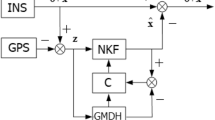Abstract
The determination of the anomalous gravity vector by inertial techniques is critically dependent on the ability to separate system errors from gravity field effects. This separation should in principle be based on the characteristic difference of the two effects: system errors are a function of time, while gravity field variations are a function of position only. Factors such as vehicle speed thus have a direct influence on the ability to separate the two effects.
In practice, inertial gravimetry has been mainly based on Kalman filteringoptimal smoothing. In Kalman filtering the error separation is in principle obtained by using different effective correlation lengths for the system errors and the anomalous gravity field variations. The advantage of Kalman filtering is the good physical description of the instrument errors, but a serious drawback is the inability to account for spatial correlations, especially for the “identical” gravity field on forward-backward traverses. Optimal smoothing with gravimetric control at the two endpoints of the traverse will remove systematic biases but will not eliminate the problem mentioned above.
An alternative post-mission adjustment method has been developed with the explicit goal to utilize repeated zero velocity updates on the same points of the traverse. In this method, the major system errors are modelled by a few parameters related to the propagation of the initial state errors, with residual errors modelled by Markov processes. Gravity vectors are solved for simultaneously in a least-squares collocation adjustment, using simplified transition matrix elements to propagate the effects of the unknown gravity field.
Results of the two methods are evaluated and compared, using Ferranti data from a number of truck and helicopter traverses in the Kananaskis area west of Calgary. In this area of extreme gravity field variation, gravity anomalies can in general be determined to an accuracy of a few mgals with theFILS system, while deflections of the vertical are typically determined at the 1 arcsec level.
Similar content being viewed by others
References
S.C. BOSE and J.R. HUDDLE: Regional adjustment of inertial gravity disturbance vector measurements by optimal two-dimensional smoothing.Proc. Second Int. Symp. Inertial Technology for Surveying and Geodesy, pp. 147–160, Banff, Canada, 1981.
R. FORSBERG and C.C. TSCHERNING: The Use of Height Data in Gravity Field Approximation by Collocation.Journ. Geoph. Res., 86, B9, pp. 7843–7854, 1981.
W.A. HEISKANEN and H. MORITZ:Physical Geodesy. W.H. Freeman Co., San Francisco, 1967.
H. MORITZ:Advanced Physical Geodesy, Herbert Wichmann Verlag, Karlsruhe, 1980.
K.P. SCHWARZ: Accuracy of vertical deflection determination by present-day inertial instrumentation. Report No. 280, pp. 273–281, Dept. Geod. Sci., The Ohio State University, Columbus, 1978.
K.P. SCHWARZ: Inertial surveying and Geodesy.Reviews of Geophysics and Space Physics, 21, No. 4, pp. 878–890, 1983a.
K.P. SCHWARZ: Inertial Adjustment Models, A study of some underlying assumptions. In:Geodesy in Transition, UCSE Report No. 60002, Division of Surveying Engineering. The University of Calgary, Calgary, Canada, 1983b.
A.A. VASSILIOU: Processing of Unifiltered Inertial Data. UCSE Report No. 20006, Division of Surveying Engineering, The University of Calgary, Calgary, Canada, 1984.
R.V.C. WONG: A Kalman Filter-Smoother for an Inertial Survey System of Local Level Type. UCSE Report No. 20001, Division of Surveying Engineering, The University of Calgary, Calgary, Canada, 1982.
D.S. ZIMMERMANN and H.C. HARRIS: General Purpose Least-Squares Adjustment of IPS data.Proc. Second Int. Symp. on Inertial Technology for Surveying and Geodesy, Banff, Canada, pp. 215–228, 1981.
Author information
Authors and Affiliations
Rights and permissions
About this article
Cite this article
Forsberg, R., Vassiliou, A.A., Schwarz, K.P. et al. Inertial gravimetry—A comparison of Kalman filtering-smoothing and post-mission adjustment techniques. Bull. Geodesique 60, 129–142 (1986). https://doi.org/10.1007/BF02521013
Received:
Accepted:
Issue Date:
DOI: https://doi.org/10.1007/BF02521013




